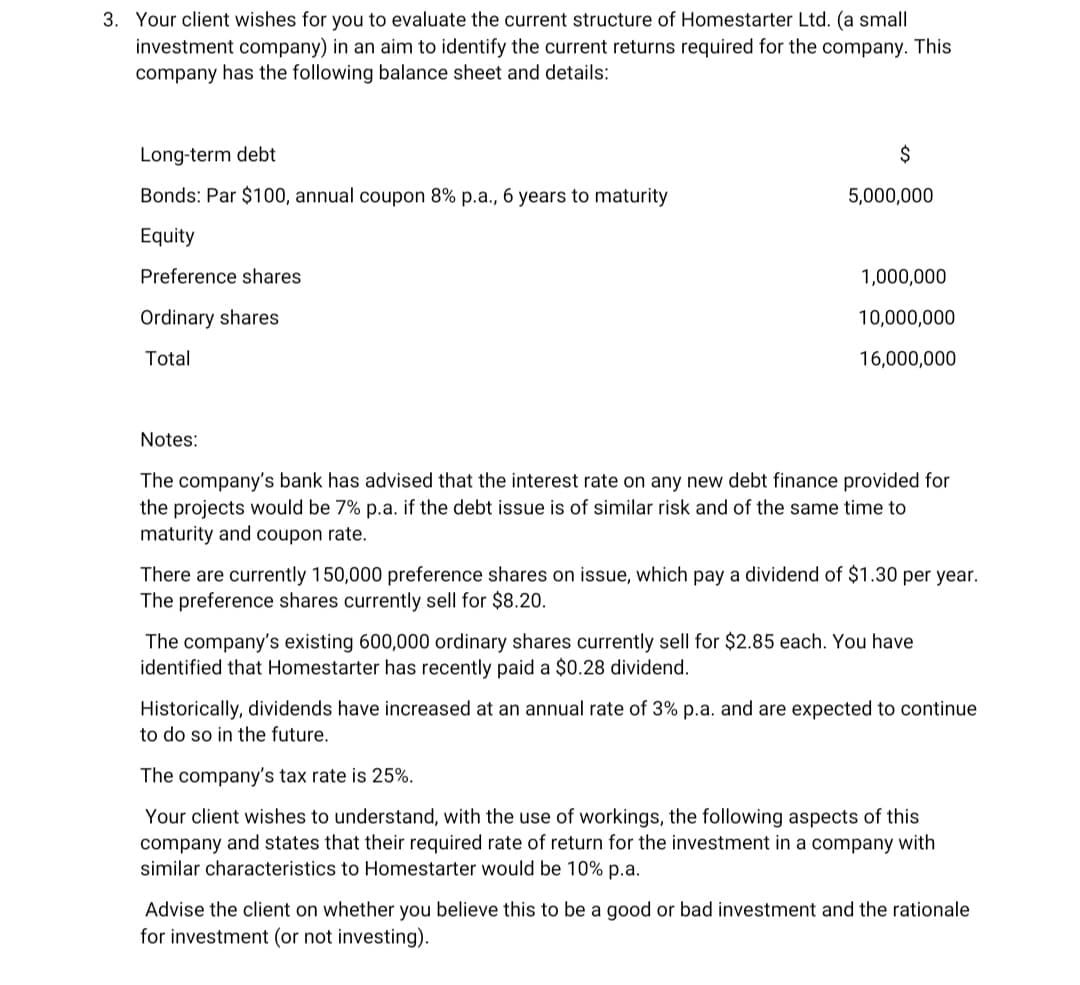a) Determine the market value proportions of debt, preference shares and ordinary equity comprising the company’s capital structure. b) Calculate the after-tax costs of capital for each source of finance and the after-tax weighted average cost of capital for the company. C) Provide recommendation to your client. d) What are the assumptions underlying the use of a dividend growth model for the estimation of a company’s cost of equity?
a) Determine the market value proportions of debt, preference shares and ordinary equity comprising the company’s capital structure. b) Calculate the after-tax costs of capital for each source of finance and the after-tax weighted average cost of capital for the company. C) Provide recommendation to your client. d) What are the assumptions underlying the use of a dividend growth model for the estimation of a company’s cost of equity?
Financial Accounting: The Impact on Decision Makers
10th Edition
ISBN:9781305654174
Author:Gary A. Porter, Curtis L. Norton
Publisher:Gary A. Porter, Curtis L. Norton
Chapter11: Stockholders' Equity
Section: Chapter Questions
Problem 11.3DC
Related questions
Question
a) Determine the market value proportions of debt,
b) Calculate the after-tax costs of capital for each source of finance and the after-tax weighted average cost of capital for the company.
C) Provide recommendation to your client.
d) What are the assumptions underlying the use of a dividend growth model for the estimation of a company’s

Transcribed Image Text:3. Your client wishes for you to evaluate the current structure of Homestarter Ltd. (a small
investment company) in an aim to identify the current returns required for the company. This
company has the following balance sheet and details:
Long-term debt
$
Bonds: Par $100, annual coupon 8% p.a., 6 years to maturity
5,000,000
Equity
Preference shares
1,000,000
Ordinary shares
10,000,000
Total
16,000,000
Notes:
The company's bank has advised that the interest rate on any new debt finance provided for
the projects would be 7% p.a. if the debt issue is of similar risk and of the same time to
maturity and coupon rate.
There are currently 150,000 preference shares on issue, which pay a dividend of $1.30 per year.
The preference shares currently sell for $8.20.
The company's existing 600,000 ordinary shares currently sell for $2.85 each. You have
identified that Homestarter has recently paid a $0.28 dividend.
Historically, dividends have increased at an annual rate of 3% p.a. and are expected to continue
to do so in the future.
The company's tax rate is 25%.
Your client wishes to understand, with the use of workings, the following aspects of this
company and states that their required rate of return for the investment in a company with
similar characteristics to Homestarter would be 10% p.a.
Advise the client on whether you believe this to be a good or bad investment and the rationale
for investment (or not investing).
Expert Solution
This question has been solved!
Explore an expertly crafted, step-by-step solution for a thorough understanding of key concepts.
This is a popular solution!
Trending now
This is a popular solution!
Step by step
Solved in 4 steps

Follow-up Questions
Read through expert solutions to related follow-up questions below.
Follow-up Question
whenever i divide 1.3 by 8.2 I get 15.85 but on the answer sheet its saying the answer should be 15.82%. Do i need to subtract the 3% that the dividends usually grow at for the
Solution
Recommended textbooks for you

Financial Accounting: The Impact on Decision Make…
Accounting
ISBN:
9781305654174
Author:
Gary A. Porter, Curtis L. Norton
Publisher:
Cengage Learning

Fundamentals of Financial Management, Concise Edi…
Finance
ISBN:
9781305635937
Author:
Eugene F. Brigham, Joel F. Houston
Publisher:
Cengage Learning

Fundamentals of Financial Management, Concise Edi…
Finance
ISBN:
9781285065137
Author:
Eugene F. Brigham, Joel F. Houston
Publisher:
Cengage Learning

Financial Accounting: The Impact on Decision Make…
Accounting
ISBN:
9781305654174
Author:
Gary A. Porter, Curtis L. Norton
Publisher:
Cengage Learning

Fundamentals of Financial Management, Concise Edi…
Finance
ISBN:
9781305635937
Author:
Eugene F. Brigham, Joel F. Houston
Publisher:
Cengage Learning

Fundamentals of Financial Management, Concise Edi…
Finance
ISBN:
9781285065137
Author:
Eugene F. Brigham, Joel F. Houston
Publisher:
Cengage Learning

Financial Reporting, Financial Statement Analysis…
Finance
ISBN:
9781285190907
Author:
James M. Wahlen, Stephen P. Baginski, Mark Bradshaw
Publisher:
Cengage Learning

